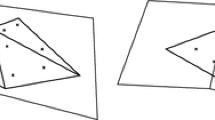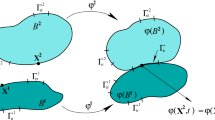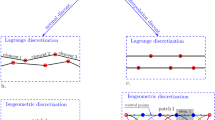Abstract
In this paper, a new approach is proposed to improve efficiency of the integration procedure for mortar integrals within finite element mortar methods for contact. Appropriate approaches subdivide polygonal integration segments into triangular integration cells where well-established quadrature rules can be applied for numerical integration. Here, a subdivision of segments into quadrilateral integration cells is proposed and investigated in detail. By this procedure, the numerical effort is decreased because the number of integration cells is smaller and less quadrature points are needed. In all the aforementioned methods, necessary projections of integration points result in rational polynomials in the integrand. Thus, an exact numerical integration is impossible. Using quadrilateral integration cells additionally involves non-constant Jacobian determinants which further increases the polynomial degree of the integrand. Numerical experiments indicate, that the resulting increase in the error is small enough to be acceptable in consideration of the gained speed-up.















Similar content being viewed by others
References
Ben Belgacem F, Hild P, Laborde P (1998) The mortar finite element method for contact problems. Math Comput Model 28(4–8):263–271
Belytschko T, Liu WK, Moran B, Elkhodary KI (2014) Nonlinear finite elements for continua and structures, 2nd edn. Wiley, Chichester
Bernardi C, Mayday Y, Patera AT (1994) A new nonconforming approach to domain decomposition: the mortar element method. In: Brézis H, Lions JL (eds) Nonlinear partial differential equations and their applications. no. XI in Collège de Frace Seminar, Longman, Harlow, pp 13–51
Cichosz T, Bischoff M (2011) Consistent treatment of boundaries with mortar contact formulations using dual Lagrange multipliers. Comput Methods Appl Mech Eng 200(9–12):1317–1332
Dunavant DA (1985) Economical symmetrical quadrature rules for complete polynomials over a square domain. Int J Numer Methods Eng 21(10):1777–1784
El-Abbasi N, Bathe KJ (2001) Stability and patch test performance of contact discretizations and a new solution algorithm. Comput Struct 79(16):1473–1486
Farah P, Popp A, Wall WA (2014) Segment-based vs. element-based integration for mortar methods in computational contact mechanics. Comput Mech 55(1):209–228
Fischer KA, Wriggers P (2005) Frictionless 2D contact formulations for finite deformations based on the mortar method. Comput Mech 36(3):226–244
Fischer KA, Wriggers P (2006) Mortar based frictional contact formulation for higher order interpolations using the moving friction cone. Comput Methods Appl Mech Eng 195(37–40):5020–5036
Francavilla A, Zienkiewicz OC (1975) A note on numerical computation of elastic contact problems. Int J Numer Methods Eng 9(4):913–924
Gitterle M, Popp A, Gee MW, Wall WA (2010) Finite deformation frictional mortar contact using a semi-smooth Newton method with consistent linearization. Int J Numer Methods Eng 84(5):543–571
Gitterle M (2012) A dual mortar formulation for finite deformation frictional contact problems including wear and thermal coupling. Dissertation, Technische Universität München
Hartmann S, Brunssen S, Ramm E, Wohlmuth B (2007) Unilateral non-linear dynamic contact of thin-walled structures using a primal-dual active set strategy. Int J Numer Methods Eng 70(8):883–912
Hintermüller M, Ito K, Kunisch K (2002) The primal-dual active set strategy as a semismooth newton method. SIAM J Optimiz 13(3):865–888
Hüeber S, Stadler G, Wohlmuth B (2008) A primal-dual active set algorithm for three-dimensional contact problems with coulomb friction. SIAM J Sci Comput 30(2):572–596
Hughes TJR, Taylor RL, Sackman JL, Curnier A, Kanoknukulchai W (1976) A finite element method for a class of contact-impact problems. Comput Methods Appl Mech Eng 8(3):249–276
Kikuchi N, Oden J (1988) Contact problems in elasticity. Society for industrial and applied mathematics, Studies in applied and numerical mathematics
Laursen TA (2003) Computational contact and impact mechanics. Springer, Berlin
McDevitt TW, Laursen TA (2000) A mortar-finite element formulation for frictional contact problems. Int J Numer Methods Eng 48(10):1525–1547
Mousavi SE, Xiao H, Sukumar N (2010) Generalized gaussian quadrature rules on arbitrary polygons. Int J Numer Methods Eng 82(1):99–113
Papadopoulos P, Taylor RL (1992) A mixed formulation for the finite element solution of contact problems. Comput Methods Appl Mech Eng 94(3):373–389
Popp A, Gee MW, Wall WA (2009) A finite deformation mortar contact formulation using a primal-dual active set strategy. Int J Numer Methods Eng 79(11):1354–1391
Popp A, Gitterle M, Gee MW, Wall WA (2010) A dual mortar approach for 3D finite deformation contact with consistent linearization. Int J Numer Methods Eng 83(11):1428–1465
Popp A (2012) Mortar methods for computational contact mechanics and general interface problems. Dissertation, Technische Universität München
Popp A, Seitz A, Gee MW, Wall WA (2013) Improved robustness and consistency of 3D contact algorithms based on a dual mortar approach. Comput Methods Appl Mech Eng 264:67–80
Puso MA, Laursen TA (2003) Mesh tying on curved interfaces in 3D. Eng Comput 20(3):305–319
Puso MA, Laursen TA (2004) A mortar segment-to-segment contact method for large deformation solid mechanics. Comput Methods Appl Mech Eng 193(6–8):601–629
Puso MA, Laursen TA (2004) A mortar segment-to-segment frictional contact method for large deformations. Comput Methods Appl Mech Eng 193(45–47):4891–4913
Puso MA, Laursen TA, Solberg J (2008) A segment-to-segment mortar contact method for quadratic elements and large deformations. Comput Methods Appl Mech Eng 197(6–8):555–566
Simo JC, Wriggers P, Taylor RL (1985) A perturbed Lagrangian formulation for the finite element solution of contact problems. Comput Methods Appl Mech Eng 50(2):163–180
Wohlmuth BI (2000) A mortar finite element method using dual spaces for the Lagrange multiplier. SIAM J Numer Anal 38(3):989–1012
Wohlmuth BI, Krause RH (2003) Monotone multigrid methods on nonmatching grids for nonlinear multibody contact problems. SIAM J Sci Comput 25(1):324
Wriggers P (2006) Computational contact mechanics, 2nd edn. Springer, Berlin
Xiao H, Gimbutas Z (2010) A numerical algorithm for the construction of efficient quadrature rules in two and higher dimensions. Comput Math Appl 59(2):663–676
Yang B, Laursen TA, Meng X (2005) Two dimensional mortar contact methods for large deformation frictional sliding. Int J Numer Methods Eng 62(9):1183–1225
Zavarise G, Wriggers P (1998) A segment-to-segment contact strategy. Math Comput Model 28(4–8):497–515
Acknowledgments
The authors would like to gratefully acknowledge the financial support of this work by the German Research Foundation (Deutsche Forschungsgemeinschaft, DFG) under Grant number BI 722/7-1. Moreover, the fruitful discussions with Anton Tkachuk and his helpful suggestions are highly appreciated.
Author information
Authors and Affiliations
Corresponding author
Rights and permissions
About this article
Cite this article
Wilking, C., Bischoff, M. Alternative integration algorithms for three-dimensional mortar contact. Comput Mech 59, 203–218 (2017). https://doi.org/10.1007/s00466-016-1345-4
Received:
Accepted:
Published:
Issue Date:
DOI: https://doi.org/10.1007/s00466-016-1345-4




